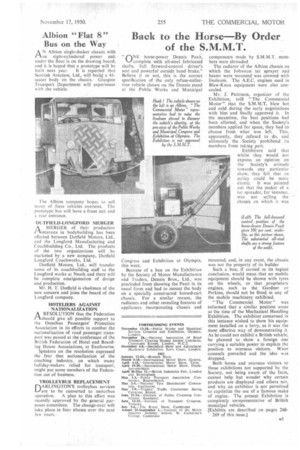Back to the Horse By Order of the S.M.M.T.
Page 37

If you've noticed an error in this article please click here to report it so we can fix it.
ONE horse-power Dennis Paxit, complete with all-steel fabricated shafts, full forward-control driver's seat and powerful outside hand brake." Believe it or not, this is the correct specification of the only refuse-collection vehicle shown on the Dennis stand at the Public Works and Municipal
Congress and Exhibition at Olympia, this week.
Because of a ban on the Exhibition by the Society of Motor Manufacturers and Traders, Dennis Bros., Ltd., was precluded from showing the Paxit in its usual form and had to mount the body on a specially constructed horsed-cart chassis. For a similar reason, the radiators and other revealing features of appliances incorporating chassis and
components made by S.M.M.T, members were shrouded.
The radiator of the Albion chassis on which the Johnston tar sprayer and heater were mounted was covered with linoleum. The A.E.C. engines used in Blaw-Knox equipment were also concealed.
Mr. J. Pattisson, organizer of the Exhibition, told "The Commercial Motor °' that the S.M.M.T, blew hot and cold during the early negotiations with him and finally approved it. In the meantime, the best positions had been allotted, and when the Society's members applied for space, they had to choose from what was left. This, apparently, they refused to do, and ultimately the Society prohibited its members from taking part.
Exhibitors said that whilst they would not express an opinion on the Society's attitude towards any particular show, they felt that its policy could be more elastic. It was pointed out that the maker of atar spreader, for instance. was not selling the chassis on which it was mounted, and, in any event, the chassis was not the property of its builder.
Such a ban, if carried to its logical conclusion, would mean that no mobile equipment should be shown with tyres on the wheels, or that -proprietary engines, such as the Gardner or Perkins, should not be fitted in any of the mobile machinery exhibited.
"The Commercial Motor" was informed that a similar position arose at the time of the Mechanical Handling Exhibition. The exhibitor concerned in this instance wished to show his equipment installed on a lorry, as it was the most effective way of demonstrating it. As he could not exhibit a British vehicle, he planned to show a foreign one carrying a suitable poster to explain the position to overseas visitors. Wiser counsels prevailed arid the idea was dropped.
Both home and overseas visitors to those exhibitions not supported by the Society, not being aware of the facts, cannot help but wonder why certain products are displayed and others not, and why an exhibitor is not permitted to capitalize the-use of a famous make of engine.. The present Exhibition is completely unrepresentative of British municipal vehicles.
[Exhibits are described on pages 265269 of this issue.]




























































































